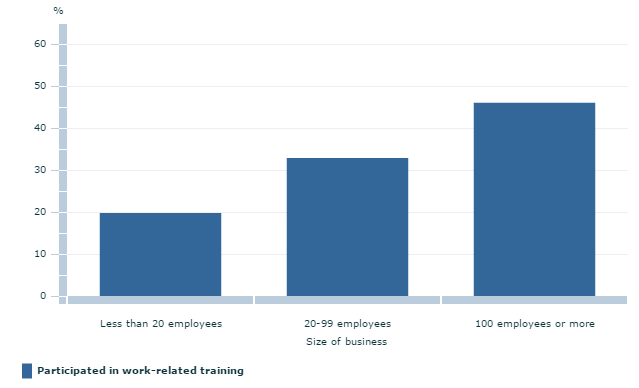In this article, we look at some of the recent statistics on employee training, and we cover some of the vast array of benefits that can be had from getting the latest in training for your employees.

Over the years, more employers are bearing the indirect wage and salary cost for the time during which their employees are receiving training. For example, the hotel industry is sending their main employees to courses such as improving their customer service, and IT companies are sending their developers to conferences that would enable them to adapt to new trends in technology.
Employers may contribute to the cost of structured training in different ways, which includes paying employees’ wages while they attend training, or paying the direct training fees and materials and even paying for their travel and accommodation expenses, related with receiving training.
Employee training statistics
During 2001-2002, 37% of the Australian population aged 15-64 years had completed at least one work-related training course. Additionally, 7% of the population had completed four or more training courses during this same period (Source: Australian Bureau of Statistics).
From 2012 – 2013, of those who had participated in work-related training in the last 12 months, just over a third (36%) reported undertaking one course, 22% undertook two courses, and 43% participated in three or more courses. Source: Work-Related Training and Adult Learning, Australia

From the graph above, we can see that the larger the company is, the more likely they would send their employees to participate in work-related training (46%) when compared with 33% of people employed in medium sized (20 to 99 employees) companies, and smaller (less than 20 employees) businesses, with only 20% of employees.
Examples of the benefits
There are a number of benefits from sending your employees for training or conferences. Besides employees gaining more knowledge and generally improving at work, the success of training can be seen via the company’s return on investment.
As an example, a service training session can lead to better customer experience and brand loyalty. An innovation training presentation can inspire your employees to approach new ways of thinking. A leadership training workshop can help employees grow more qualified for internal promotion, saving the company time and money compared to bringing in outside candidates when such opportunities arise. By looking at internal promotions instead of sourcing them from outside the company, you can therefore reduce the employee turnover rate.
At times, it is not about hiring the best talent in the market but training the employees that you already have working for you.
In Summary
With an increasing amount of training sessions being conducted over the last few years, there is an increasing need for organisations to look into using new training software, such as Prezentt, to help effectively deliver their conferences or training presentations.
For example, by using Prezentt, trainers are able to deliver their training courses and place their notes into the system, along with as many other files and links as they like. This eliminates the costs of printing, binding and distribution, by moving course materials and evaluation forms online.
As well as these benefits, participants can access training materials using any device with a browser and can take their own personal notes, ask questions, or participate in online discussions.
So what are you waiting for? Try out our demo today!

I agree that training your employees can yield a return on investment to the company. It’s especially important that your employees understand the software your company uses since it can often be updated and change. It’s wise to make sure your employees get the training they need to be comfortable and as productive as possible utilizing the software they have.